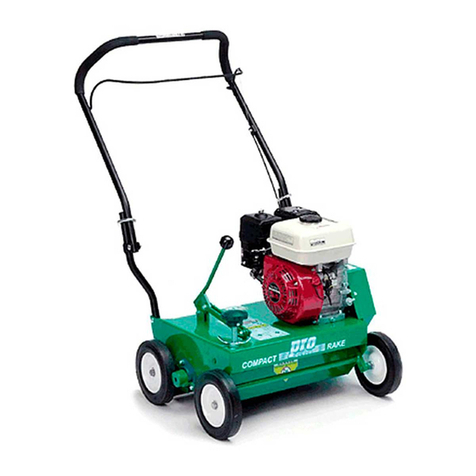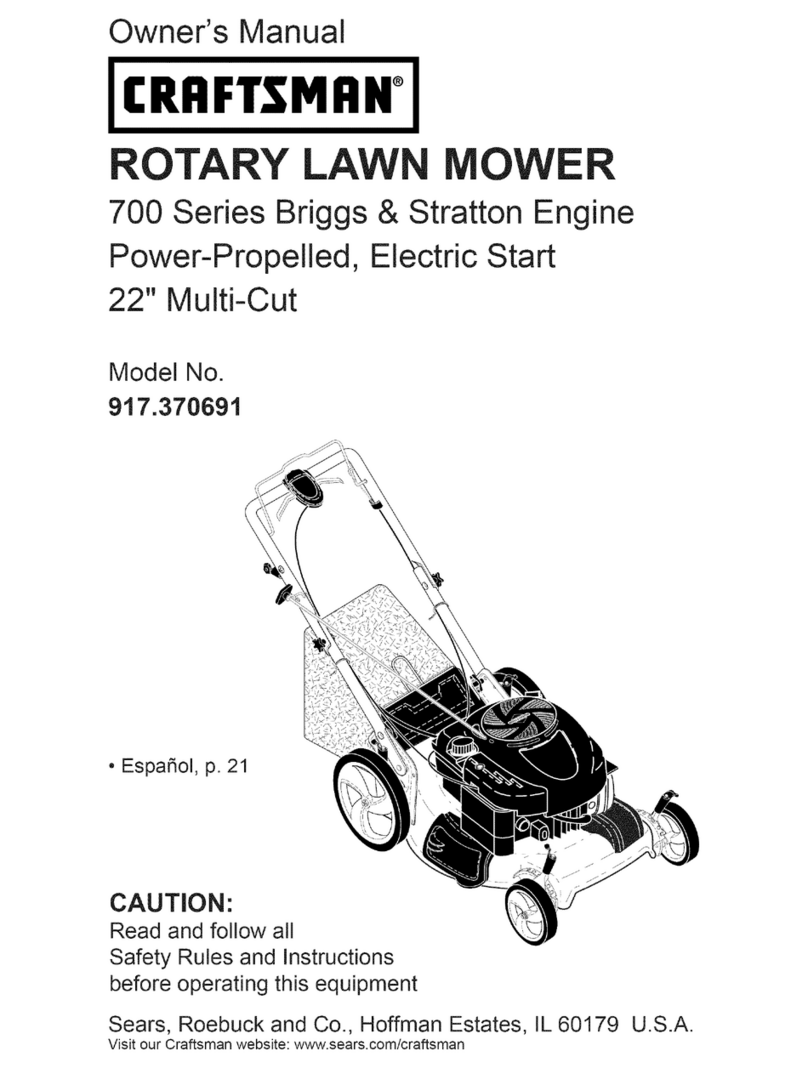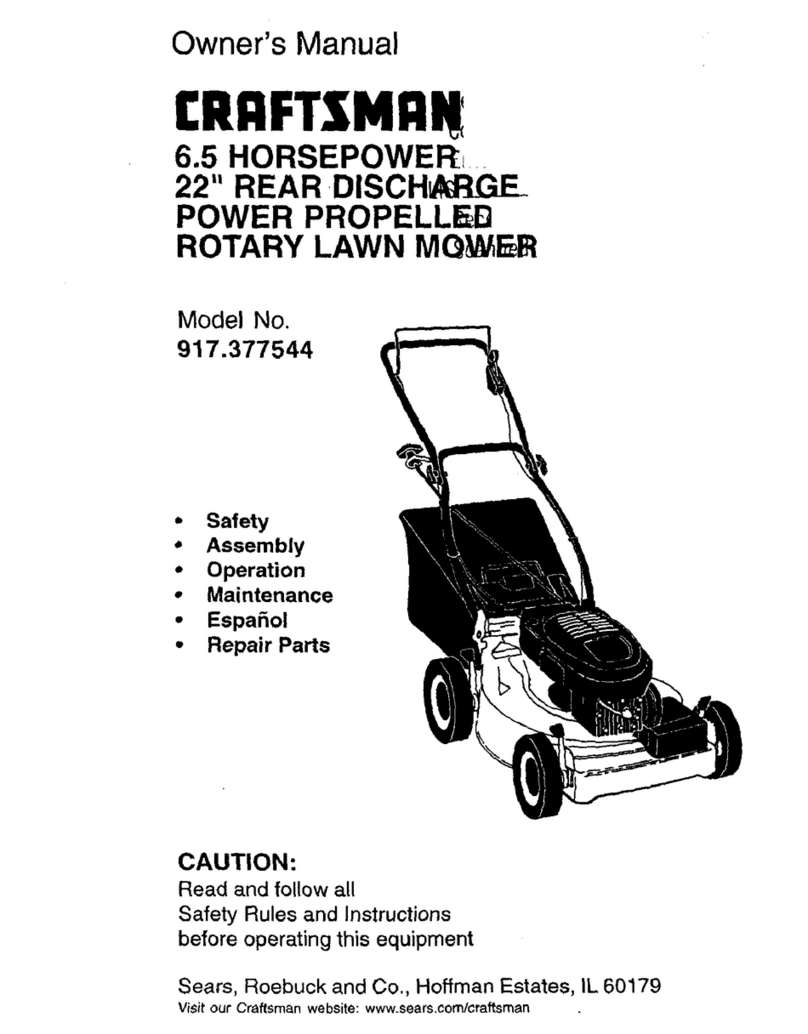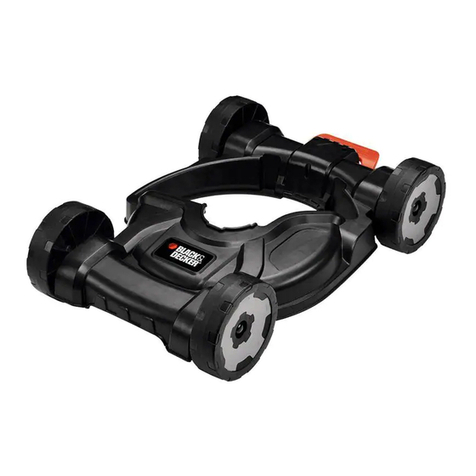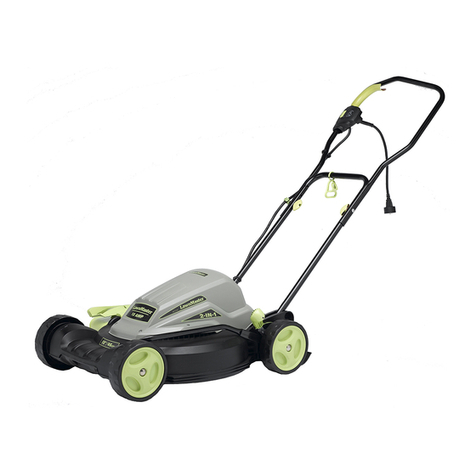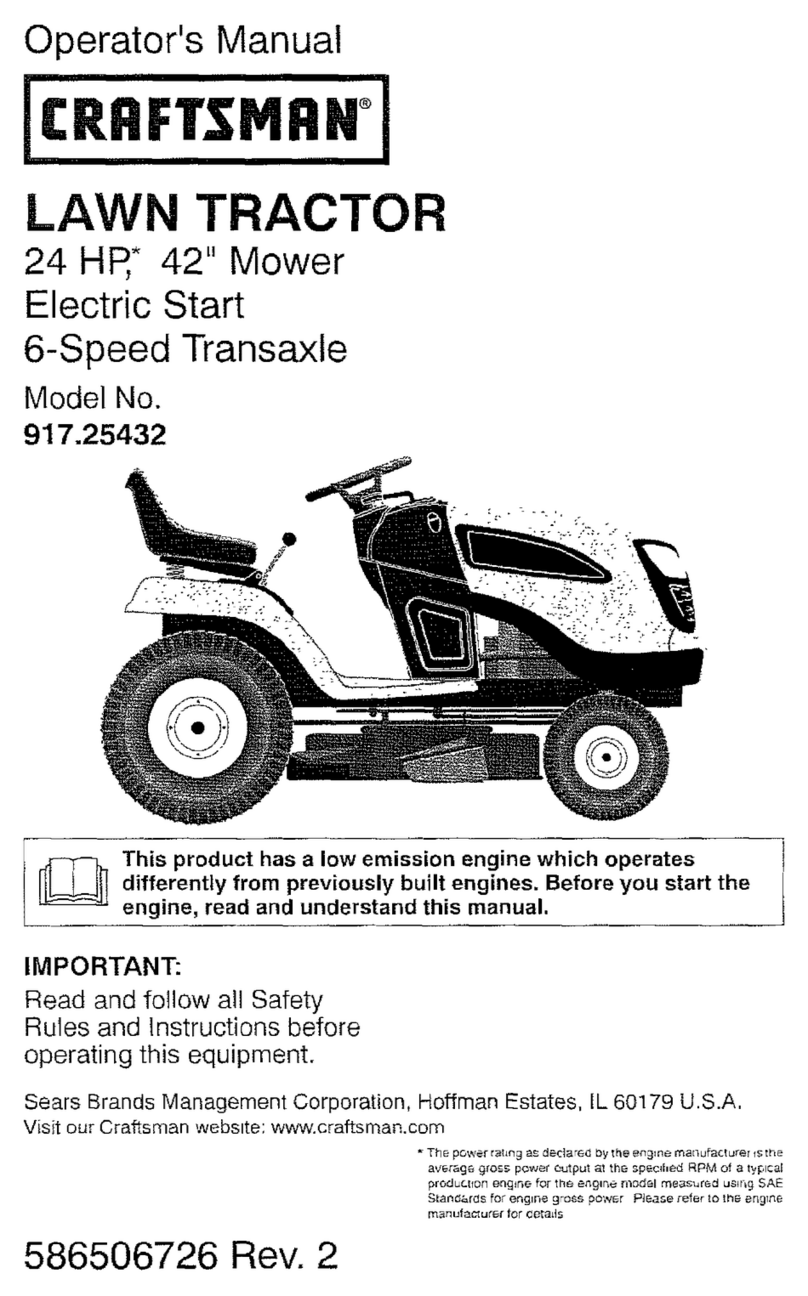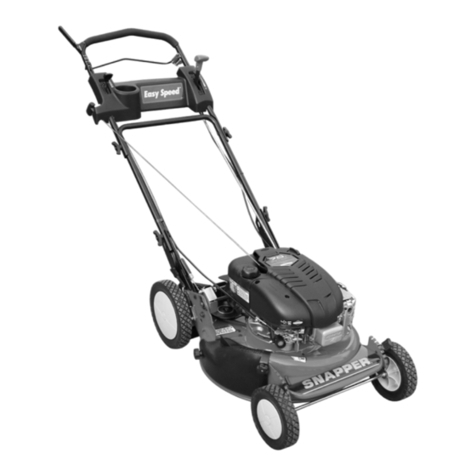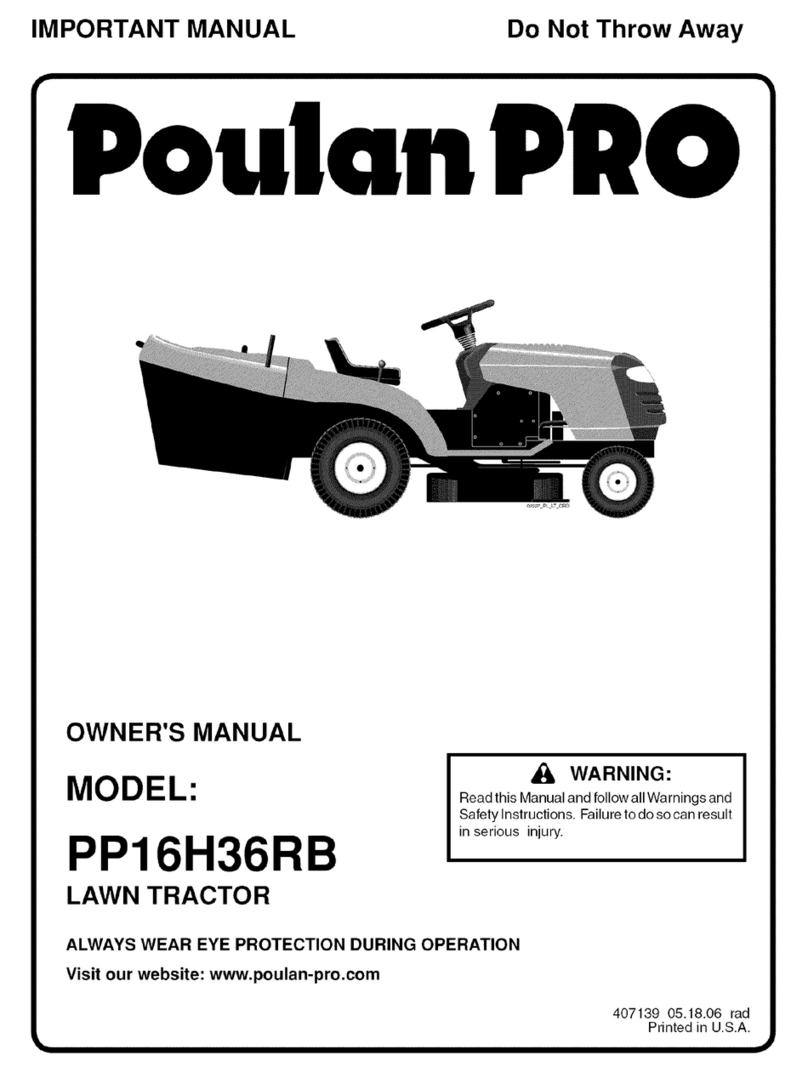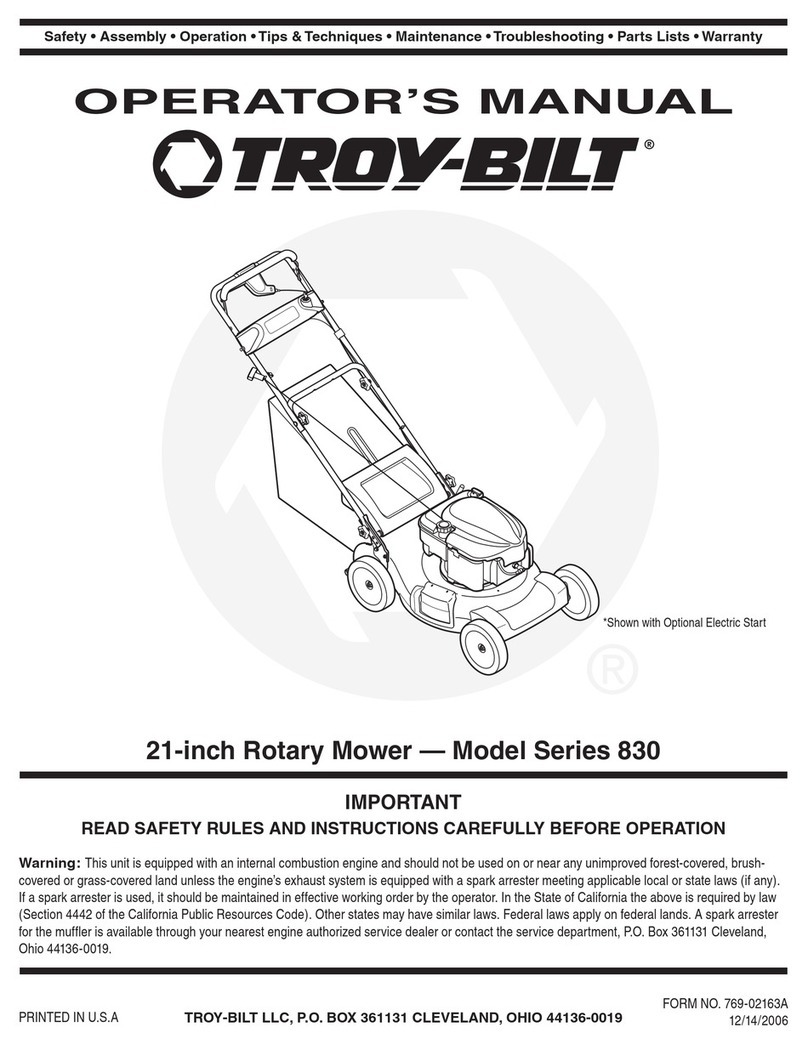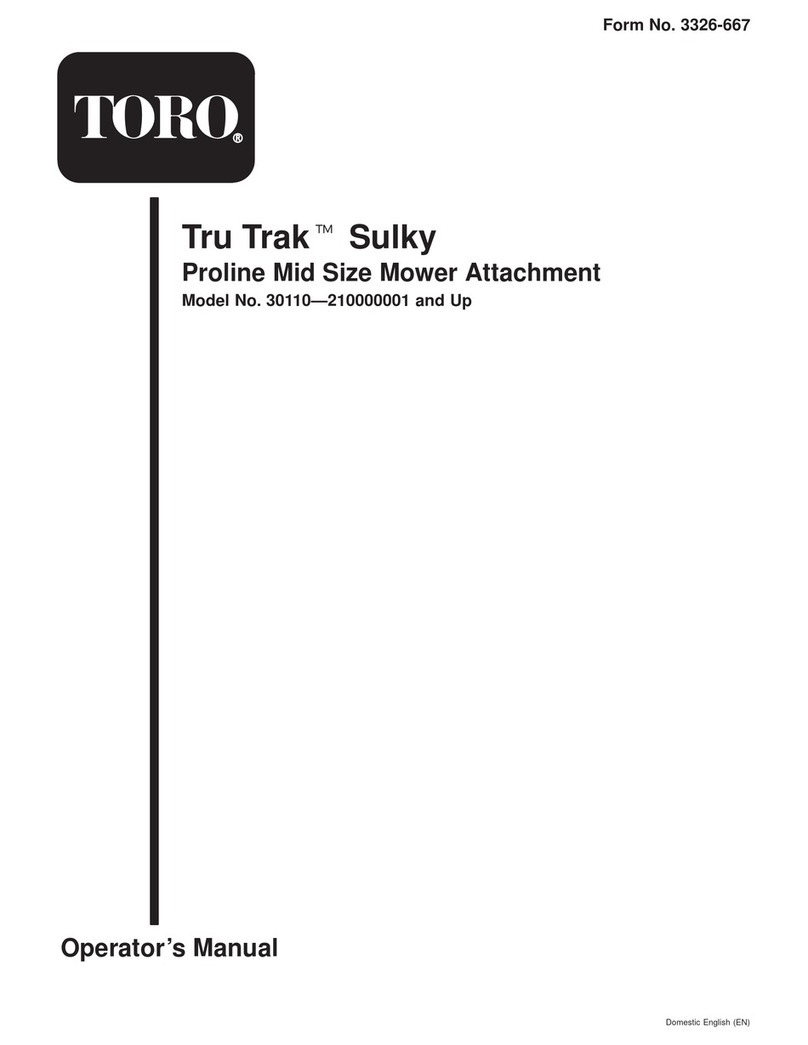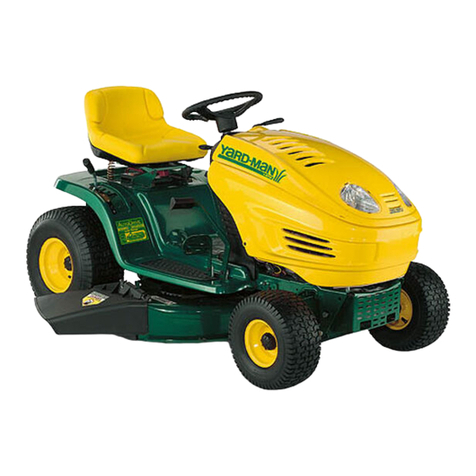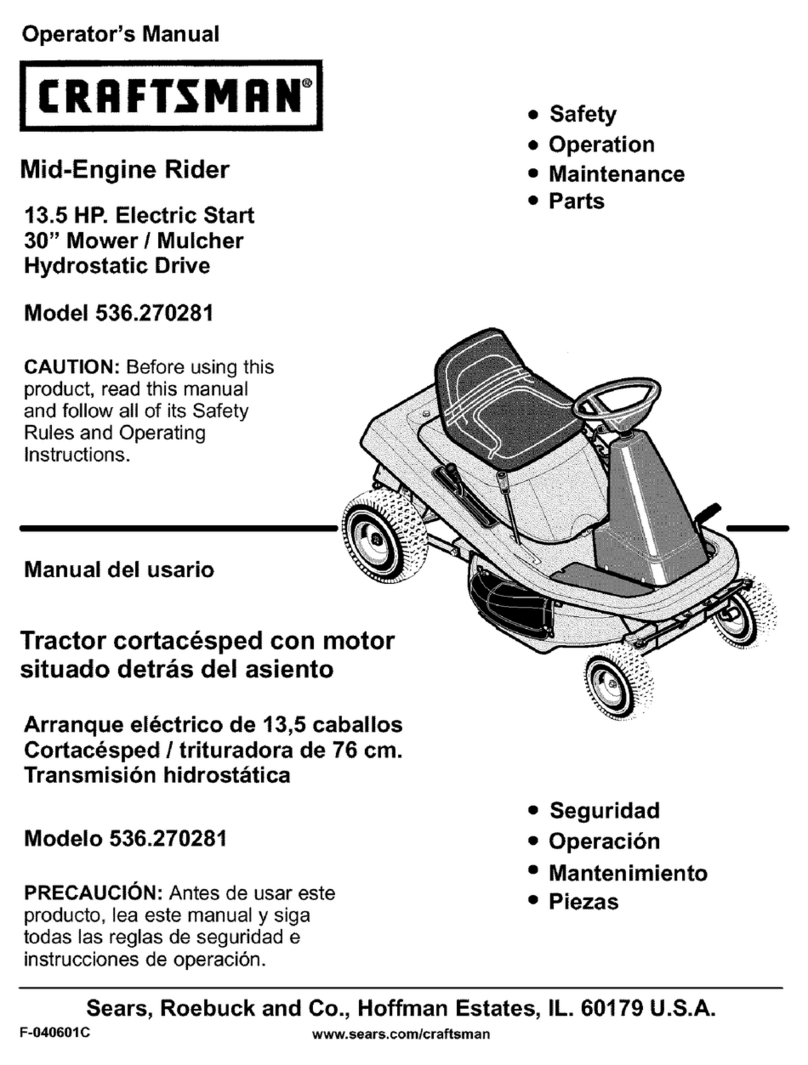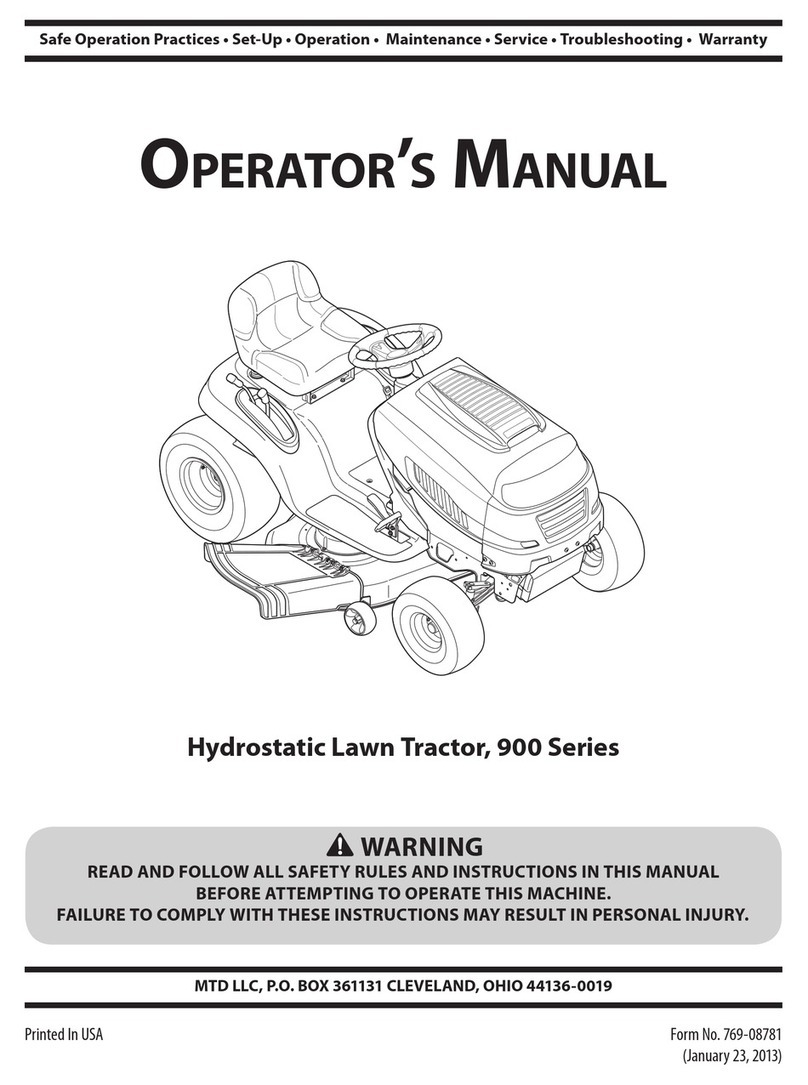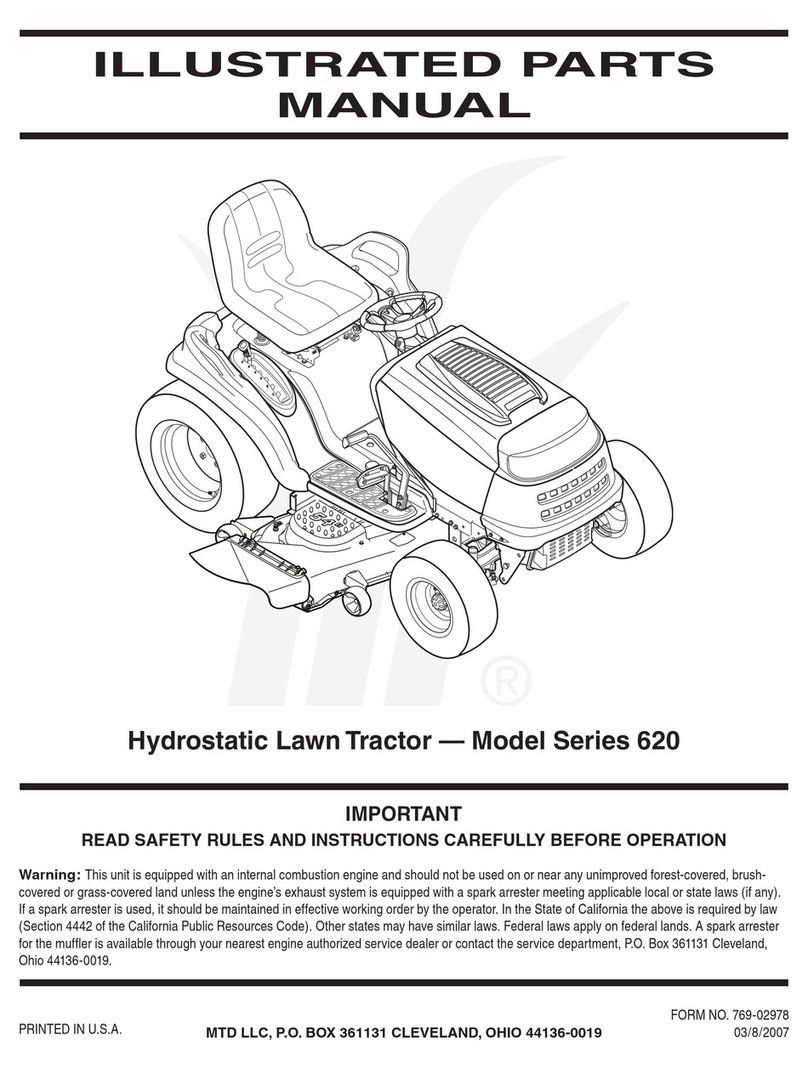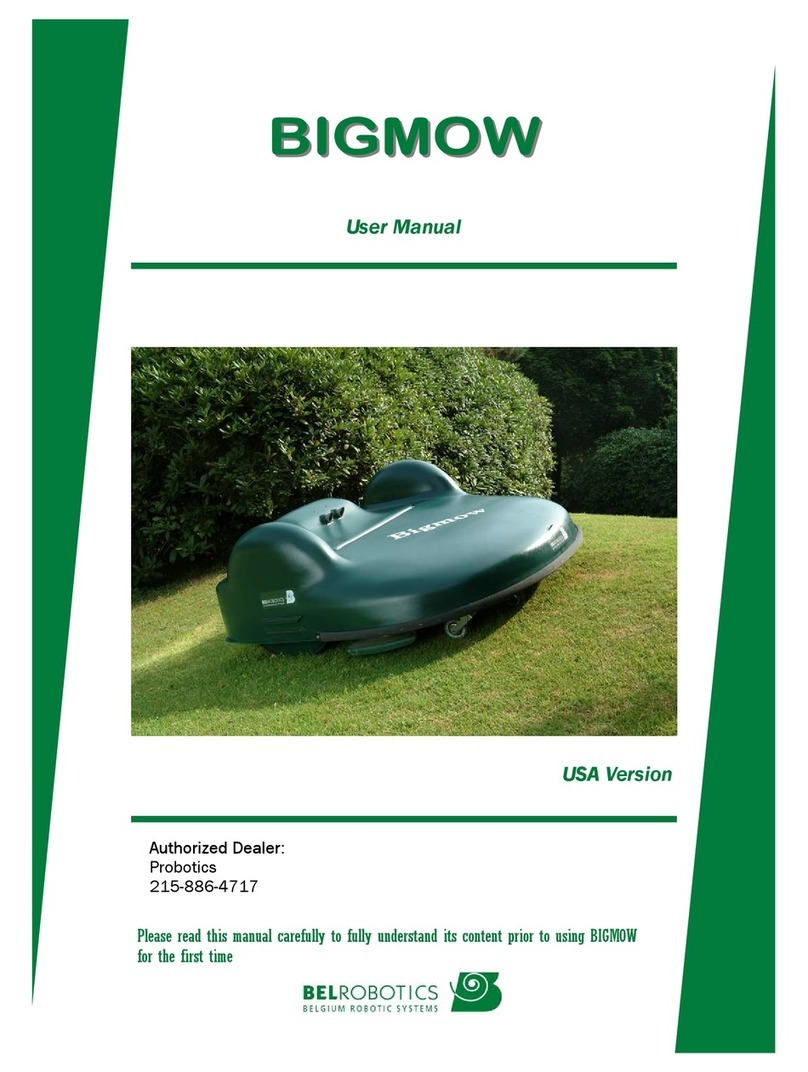Allett C 34 User manual

A member of the Turfmech group
C34”
OPERATOR & PARTS MANUAL
For Serial number C34/5-13-001 onwards
(AM81593 Issue C Jan 2013)
English version
Turfmech Machinery Limited
Hangar 5, New Road, Hixon, Stafford, ST18 0PJ, United Kingdom
Tel: +44 (0) 1889 271503
Fax: +44 (0) 1889 271321
Sales@turfmech.co.uk
www.turfmech.co.uk
For Allett spare parts
Tel: +44 (0) 1889 272095
Fax: +44 (0) 1889 271321
Sales@allett.co.uk
www.allett.co.uk

2
READ THIS MANUAL BEFORE USING AN ALLETT C34 CYLINDER MOWER.
YOUR SAFETY IS INVOLVED
IT IS ESSENTIAL THAT OPERATORS STUDY THIS DOCUMENT FOR THEIR OWN SAFETY.

3
Contents
1.0 Introduction
1.1 Model type and serial number
2.0 Pictograms and Decals
3.0 Safety notes
4.0 Assembly
5.0 Operating controls
6.0 Using your mower
6.1 Starting
6.2 Stopping
6.3 Adjusting the bottom blade - setting “on cut”
6.4 Height of cut adjustment
6.5 Engaging drive to the cylinder/cartridge
6.6 Engaging drive to the land roll
6.7 Park brake
6.8 Mowing
6.9 Removing and replacing a cartridge
7.0 Maintenance
7.1 Adjusting land drive and cylinder cables
7.2 Checking the engine oil
7.3 General engine maintenance
7.4 Fuel
7.5 Grease points
7.6 Bottom blade grinding angles
7.7 Inspection of safety critical components
7.8 Maintenance schedule
8.0 Making adjustments to your mower
8.1 Front roller scraper
8.2 Floating handle bars
8.3 Delivery plate and fins
9.0 Vibration reduction
10.0 Declaration of conformity
11.0 Fault finding when mowing
12.0 Specification
12.1 Base machine specification
12.2 Cartridge specification
13.0 Guarantee
14.0 Parts Section

4

5
1.0 Introduction
The C34 is designed predominantly as a lawn mower. However, the C34 base unit has the ability to
accept a range of 34” interchangeable cartridges to cover a number of professional turf management
tasks.
The base unit is powered by a petrol engine, it is self propelled via a belt and chain drive to the land roll.
The land roll has an internal geared differential. Power is transferred to the cartridge by a toothed coupling
and belt drive.
The C34 mower is designed for the management of high quality turf. Use in any way other than that stated
is considered contrary to the intended use. Compliance and strict adherence to the conditions of
operation, service and repair as specified in this manual also constitute essential elements of the intended
use.
The way in which the C34mower is operated and maintained will have a profound effect on its
performance and reliability.
A C34 mower should be operated, serviced and repaired only by persons who are familiar with its
particular characteristics and who are familiar with the relevant safety procedures.
The safety precautions outlined in this manual and all other generally recognised regulations on safety
must be observed at all times.
Any modifications carried out to an C34 mower will relieve Turfmech Machinery Limited of liability for any
resulting damage or injury.
This manual is based on information available at the time of publication.
Turfmech Machinery Limited reserves the right to amend product specifications without prior notification.
1.1 Model type and serial number
The model can be found in two places:
1. On the top cover of the mower.
2. On the serial number plate located on the right side of the mower chassis.
The serial number can be found on the serial plate.
Please enter your information below
Model:
Serial Number:

6
2.0 Pictograms and Decals
3.0 Safety notes
Read these instructions carefully, be familiar with the controls and the proper use of the lawnmower.
Learn how to stop the lawnmower quickly in an emergency.
Never allow children or people unfamiliar with these instructions to use the lawnmower. Local regulations
may restrict the age of the operator.
Never mow while people, especially children or pets are nearby
Never pick up or carry the lawnmower while the motor is running.
Keep in mind that the operator or user is responsible for accidents or hazards occurring to other people or
their property.
Whilst mowing, always wear substantial footwear and long trousers. Do not operate the equipment when
barefoot or wearing open sandals.
Wear appropriate protective clothing and equipment when you are operating the lawnmower, such as
safety glasses, long trousers, substantial footwear and ear protection. Long hair, loose clothing or
jewellery can get tangled in moving parts.
Thoroughly inspect the area where the lawn mower is to be used and remove all objects that may be
thrown by the machine.
WARNING - petrol is highly flammable.
- Store fuel in containers especially designed for this purpose
Refer to manual before carrying out maintenance,
Engine On/Off switch, Read manual before starting
Guaranteed Sound power level
emitted by the mower
Bottom blade to cylinder adjustment
Flying debris, keep bystanders away. Warning, sharp blades, do not touch rotating blades.
The blades continue to rotate after the mower is switched off

7
- Refuel outdoors only and do not smoke while refuelling
- Add fuel before starting the engine. Never remove the cap of the fuel tank or add petrol whilst --the
engine is running or the engine is hot.
- If petrol is spilt, do not attempt to start the engine but move the machine away from the area of spillage
and avoid creating any source of ignition until petrol vapours have dissipated.
-Replace the fuel tank and container caps securely
- Replace faulty silencers
- Do not operate the engine in a confined space where dangerous carbon monoxide fumes can collect.
- Before using, always visually inspect to see that the cartridge is not worn or damaged.
Mow only in daylight or in good artificial light.
Avoid operating the lawnmower in wet grass, where feasible.
Always be sure of your footing on slopes.
Walk, never run.
Mowing on banks can be dangerous:
- Mow across the face of sloes –never up and down.
- Be particularly careful of your footing on slopes or wet grass.
Exercise extreme caution when changing direction on slopes.
Do not mow excessively steep slopes.
- Use extreme caution when stepping back or pulling the lawnmower towards you.
Stop the blades if the lawnmower has to be tilted for transportation when crossing surfaces other than
grass and when transporting the lawnmower to and from the area to be mowed.
Do not tilt the lawnmower when starting, except if the lawnmower has to be tilted for starting in long grass
or when using a cartridge set to work below the surface. In this case, do not tilt it more than absolutely
necessary and lift only the part which is away from the operator. Always ensure that both hands are in the
operating position returning the mower to the ground.
Never operate the lawnmower with defective guards or without the safety devices, for example deflectors
and grass catchers in place.
Do not change the engine governor settings or overspeed the engine. Operating an engine at excessive
speed may increase the hazard of personal injury.
Disengage all blade drive clutches before starting the engine
Start the engine carefully according to instructions and with feet well away from the blades. Do not tilt the
mower when starting. Keep clear of the discharge opening at all times. Never pick up or carry a
lawnmower while the engine is running.
Do not put hands or feet near or under rotating parts while the lawnmower is being operated.
Stop the engine and disconnect the spark plug lead:
- Before checking, cleaning or working on the lawnmower
- After striking a foreign object, inspect the lawnmower for damage and make repairs before restarting and
operating the lawnmower.
- If the lawn mower starts to vibrate abnormally (check immediately).
- Before making height of cut adjustment
Stop the engine:
- Whenever you leave the machine
- Before refuelling
- Before checking blockages
- Before making a height of cut adjustment
Reduce the throttle setting during engine shut-down and turn the fuel off at the conclusion of mowing.
Keep all nuts, bolts and screws tight to be sure that the lawnmower is in safe working condition.
Never store the lawnmower with petrol in the tank inside a building where fumes may reach an open flame
or spark.
Allow the engine to cool before starting in any enclosure.
To reduce the fire hazard, keep the engine, silencer and fuel storage area free of grass, leaves or
excessive grease.
Check the grassbox frequently for wear or deterioration.

8
Replace worn or damaged parts for safety.
Go slow when using a trailing seat, especially when cornering.
If the fuel tank has to be drained, this should be done outdoors.
Be careful during the adjustment of the lawnmower to prevent entrapment of the feet and hands between
moving blades and fixed parts of the lawnmower.
Ensure replacement parts fitted are manufacturer’s original or approved by the manufacturer.
4.0 Assembly
1) Fold handles back to a comfortable operator height and tighten 4 bolts
2) Fold down grass box cradle and fit grass box
3) Release the handbrake
1
x4
3
2

9
5.0 Operating controls
2
1
3
4
5
6
7
8
16
9
10
17
12
14
18
13
11
15

10
1) Handle bar ON/OFF switch
14) Choke lever
2) Throttle
15) Oil dipstick
3) Cutting cylinder engagement
16) Spark plug
4) Land roll engagement
17) Air filter
5) Park brake
18) Fuel tank
6) Top handle bar
19) Bottom blade adjuster
7) Cable adjuster
20) Cartridge drive coupling
8) Bottom handle bar
21) Front roller adjuster
9) Grass box cradle
22) Front roller scraper
10) Grass box
23) Front roller
11) Engine ON/OFF switch
24) Cartridge securing screw
12) Starter grip
25) Kick stand
13) Fuel valve lever
26) Vibration mounts
20
21
23
19
24
25
26
22

11
6.0 Using your mower
6.1 Starting
1) Move the fuel valve lever to the ON
position
2) For a cold start move the
choke lever to the CLOSED
position |\|
To restart a warm engine
leave the choke lever in the
OPEN position
MAX
MIN
1/3 position
3) Set the throttle to 1/3 position
between MIN and MAX
4) Turn the engine switch to the ON
position
5) Move the handle bar mounted engine
switch to the ON position

12
6.2 Stopping
1) Move the throttle lever to MIN position
2) Move the handle bar mounted stop switch to OFF
3) Turn the petrol tap OFF
To stop in an emergency move the handle bar mounted stop switch to OFF
6.3 Adjusting the bottom blade - setting “on cut”
For grass cutting cylinder cartridges only.
The bottom blade is correctly adjusted when the cutting cylinder lightly brushes the bottom blade as the
cylinder is turned. Contact should be made across the full width of the bottom blade.
The blades act like a pair of shears, as a test correctly adjusted blades will cleanly cut a piece of good
quality writing paper across the width of the blade. The bottom blade should be adjusted if the grass is not
cut cleanly and evenly.
WARNING –Blades are sharp always wear gloves
6) Pull the starter grip lightly grip
until you feel resistance, then
pull briskly. Return the starter
grip gently
7) If the choke lever was moved to
the CLOSED position |\| to start
the engine, gradually move it to
the OPEN position |||as the
engine warms up

13
To set the cutting cylinder cartridge on cut:
1) Tilt the mower back and wedge securely
2) Turn the adjuster screws anti clockwise to move the bottom blade closer to the cylinder
Turn the adjuster screws clockwise to move the bottom blade further from the cylinder
3) When making adjustments to the bottom blade frequently check progress by cutting a piece of
paper
Do not over tighten the bottom blade –the cylinder should be able to spin freely
If you are still unable to cleanly cut paper, inspect the bottom blade and cylinder. If they appear, rounded,
damaged or excessively worn they may need to be reground or replaced. New bottom blades should
always be reground attached to the bottom blade carrier. For bottom blade grinding angles see the section
7.6
The bottom blade adjusters can sometimes become very tight and may be hard to turn. If this is the case:
1) Slacken off the grub screw on the collar
2) Rotate the adjuster anti-clockwise 1/8th of a turn
3) Tighten the grub screw
Bottom blade
adjustment decal
1 & 3
2

14
6.4 Height of cut adjustment
The height of cut is set by altering the position of the front roller.
WARNING - blades are sharp, always wear gloves
For a cutting cylinder cartridge:
1) Set “on cut” first, refer to section 6.3
2) Adjust and lock the bolt on the height setting bar to your desired height of cut
3) Slacken the four front roller fasteners
4) Tilt the mower back and wedge securely
5) With the height setting bar near one end of the bottom blade, locate the bolt head on top of the bottom
blade and under the rear roller
6) Adjust the front roller so it makes contact with the height setting bar
7) Tighten the front roller fasteners on the side you have adjusted
8) Move the height setting bar to the other end of the bottom blade and repeat steps 5-8
For all other turf maintenance cartridges:
2) Adjust and lock the bolt on the height setting bar to your desired working height or depth
3) Slacken the four front roller fasteners
4) Tilt the mower back and wedge securely
5) With the height setting bar near one edge of the cartridge, position one end against the rear roller
6) Adjust the front roller so it makes contact with the height setting bar and the bolt head lines up with the
blade/tine/bristle
7) Tighten the front roller fasteners on the side you have adjusted
8) Move the height setting bar to the other end of the cartridge and repeat steps 5-8
Front roller
Cartridge
Rear roller
Depth of work
Height bar
Front roller
Cutting cylinder
Rear roller
Bottom
blade
Height of
cut
Height bar

15
6.5 Engaging drive to the cylinder/cartridge
1) Gradually squeeze the cylinder/cartridge bail bar towards the top handle
2) Release the bail bar to stop the cylinder/cartridge
6.6 Engaging drive to the land roll
1) Gradually squeeze the drive bail bar towards the top handle
2) Release the bail bar to stop forward movement
6.7 Park brake
The park brake is designed to lock the transmission. DO NOT use the park brake whilst the mower is
moving, only apply it when the mower is stationary.
To engage the park brake:
1) Pull and hold the red lever on the top handle bar
2) Tighten the lock handle
6.8 Mowing
1) Before mowing check the engine oil level and fill the petrol tank (see maintenance section)
2) Start the engine –see section 6.1
3) Engage drive to the cylinder/cartridge
4) Release the park brake
5) Engage drive to the land roll
6.9 Removing and replacing a cartridge
WARNING - blades are sharp, always wear gloves
To remove a cartridge:
1) Stop the engine and apply the park brake
2) Lower the kick stand –WARNING the mower will become unstable when the cartridge is removed, the
kick stand prevents instability
3) Remove the grass box and fold up the grass box cradle
4) Loosen the cartridge securing hand wheel
5) Slide the cartridge across to separate the drive coupling
6) Lift the cartridge out using the handle. Obtain assistance if required. WARNING - some cartridges are
above 25kg
1
2
3
4
5
6

16
To replace a cartridge:
1) Stop the engine and apply the park brake
2) Lower the kick stand –WARNING the mower will become unstable when the cartridge is removed, the
kick stand prevents instability
3) Remove the grass box and fold up the grass box cradle
4) Lift the cartridge in to the frame using the handle. Obtain assistance if required.
WARNING - some cartridges are above 25kg.
5) Align the teeth on the drive coupling, use the indicator marks to help
6) Slide the cartridge across to engage the drive coupling
7) Tighten the hand wheel to secure the cartridge in place
7.0 Maintenance
WARNING –Stop the engine and remove the spark plug cap
To ensure long and reliable service, carry out the following maintenance regularly:
Regularly check for obvious defects such as a loose, dislodged or damaged blades, loose fixings and
worn or damaged components.
Check that covers and guards are undamaged and correctly fitted. Carry out necessary maintenance or
repairs before using.
Clean the exterior of the machine thoroughly using a soft brush and cloth. Remove all debris, especially
from the air filter and engine fins.
If the mower should happen to fail despite the care taken in manufacture and testing, repair should be
carried out by an authorised Allett dealer.
7.1 Adjusting land drive and cylinder cables
If the mower or cylinder doesn’t drive adequately it may be necessary to adjust the drive cable as follows:
1) Slacken lock nut
2) Turn the adjuster a few times clockwise
3) Retighten the adjuster with the lock nut
When correctly adjusted, drive to the rear roller or cylinder is engaged when the bail bar is squeezed
against the top handle. When released drive should disengage.
1 & 3
2

17
7.2 Checking the engine oil
Change the engine oil after the first 8 hours of use. The oil should then be changed every 50 hours or at
the end of each season before storage, which ever is sooner.
1) With the mower standing on level ground, unscrew and remove the engine oil filler dipstick (X)
2) Wipe the oil filler dipstick clean: insert the oil dipstick, then remove it again. Do not screw it in.
3) Check the oil level
4) Add a good quality SAE10W-30 oil in small quantities at a time, allowing it to settle. Repeatedly add oil
and check the level until it reaches the upper limit.
SAE 10W-30 oil is recommended for general use. It is important to use the recommended oil to avoid
damage to your engine. Engine oil capacity is 0.6L
7.3 General engine maintenance
Check and clean the air filter (X), replace if necessary. See engine manual for details.
Check and clean the fuel sediment bowl and spark plug. See engine manual for details.
For all other engine adjustments and maintenance refer to the engine manual.

18
7.4 Fuel
Petrol deteriorates over time. Engine starting may be difficult if you use petrol kept for more than 30days.
Always run the fuel tank dry when storing over 30 days.
1) Remove the petrol filler cap (X), slowly add unleaded petrol to the tank, fill to approximately the top of
the strainer gauze.
2) Replace petrol filler cap
3) Wipe up any spilt petrol from the engine before starting the mower
7.5 Grease points
8 Grease points in total
(Remove covers to access grease points)
A) 2 cartridge bearings (1 pump every 1-2 weeks)
B) 2 rear roller bearings (1 pump every month)
C) 3 drive shaft bearings (1 pump every 1-2 weeks)
D) 1 idler pulley bearing (1 pump every 1-2 weeks)
Recommended best practice is to grease little and often
7.6 Bottom blade grinding angles
For cylinder cutting cartridges only. The cutting performance of the C34 is highly dependant on the
condition of both the cylinder and bottom blade. Poorly maintained parts will lead to a poor quality of cut.
Newly fitted bottom blades will need to be ground when bolted to the blade carrier to ensure a perfectly flat
cutting edge.
It is advisable that grinding/reconditioning is carried out by an authorised Allett dealer to the angles shown
below.
A
D
C
B

19
7.7 Inspection of safety critical components
The below parts are critical to the safe operation of your lawnmower, before each use check that:
When the park brake is engaged the mower can not move.
The guards, deflectors and the grass box are in good condition and secured in place
The On/off engine switch stops the mower in case of an emergency
When the bail bars are released the cylinder/cartridge and land roll drive stop immediately
7.8 Maintenance schedule
Activity
Task
Daily
Weekly
Monthly
Yearly
Check
Engine oil level
●
Fuel level
●
Air cleaner condition
●
Guards in place
●
Cutting cylinder/cartridge
●
Fasteners
●
Chain and belt tension
●
Spark plug
●
Clean
Debris/grass from mower
●
Engine cooling fins
●
Fuel sediment bowl
●
Air filter elements
●
Inside guards
●
Test
Parking brake
●
On/off switches
●
Drive engagement/disengagement
●
Replace
Engine oil
●
Spark plugs
●
Air filter elements
●

20
8.0 Making adjustments to your mower
8.1 Front roller scraper
To keep the front roller clean it is fitted with an adjustable scraper. To adjust the scraper:
1) Slacken the two locking screws
2) Move the scraper bar so there is minimal clearance between the bar and the roller
3) Tighten the two locking screws
8.2 Floating handle bars
The upper and lower handle bars are isolated with rubber vibration mounts. The lower handle bar is also
suspended via springs. The sprung lower handle bar is designed to “float” off the rubber stops when in
use. The spring tension can be adjusted by rotating the spring anchor.
1) Slacken the locking nut
2) Rotate the spring anchor to adjust spring tension
3) Tighten the locking nut
1 & 3
2
1 & 3
2
Other manuals for C 34
2
Table of contents
Other Allett Lawn Mower manuals
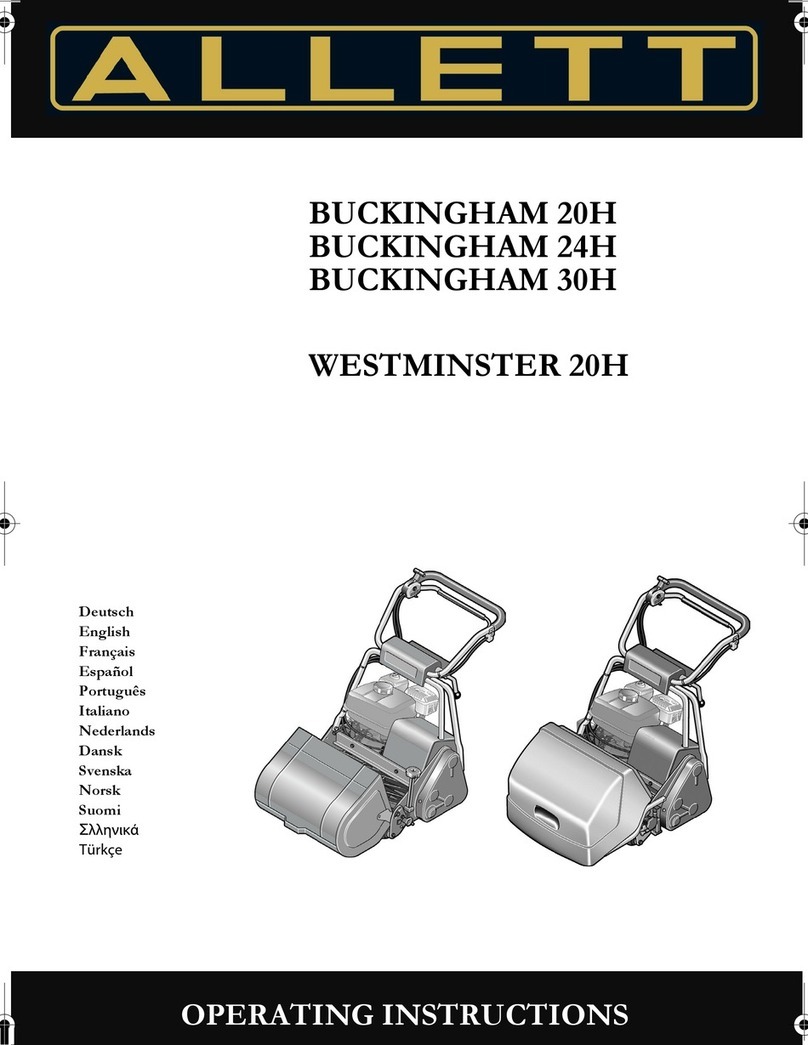
Allett
Allett BUCKINGHAM 20H User manual
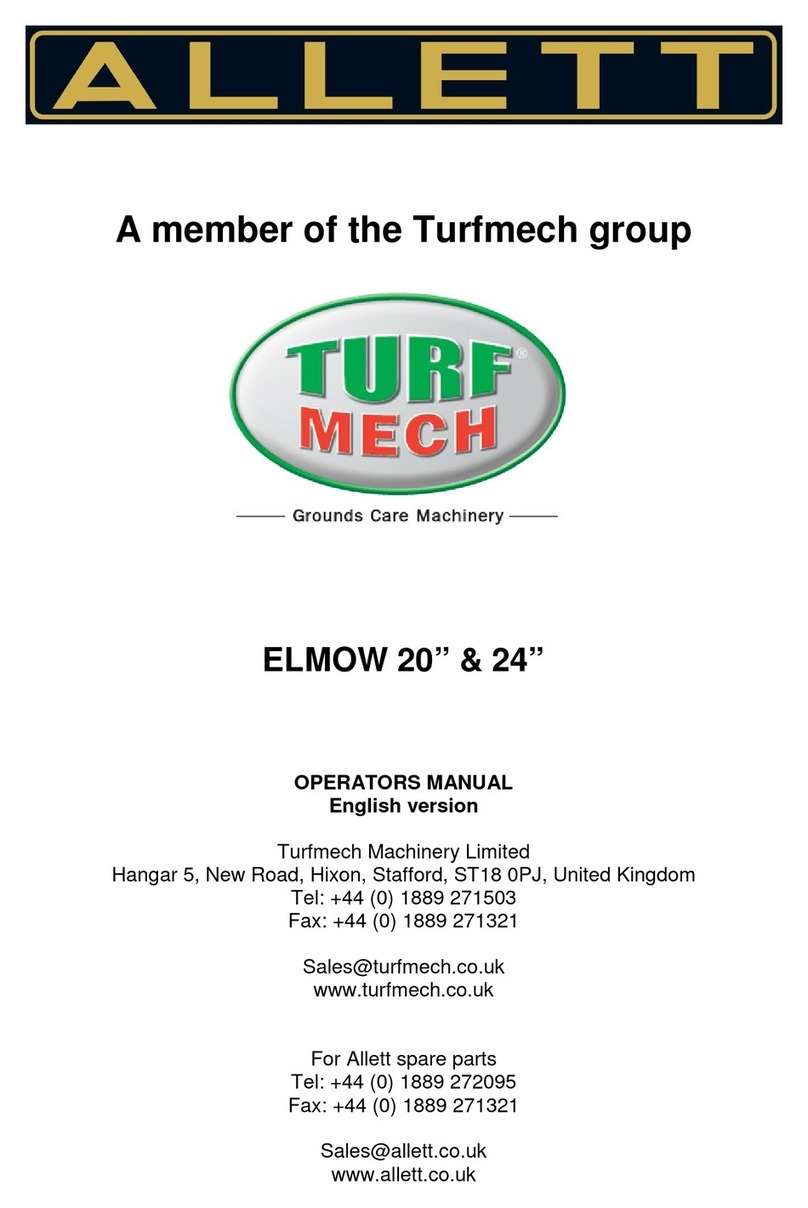
Allett
Allett ELMOW 20 User manual

Allett
Allett Liberty Classic Push 30cm User manual

Allett
Allett C 34 Guide

Allett
Allett Liberty Classic Push 30cm User manual

Allett
Allett Stirling 43 Aerator Cartridge User manual
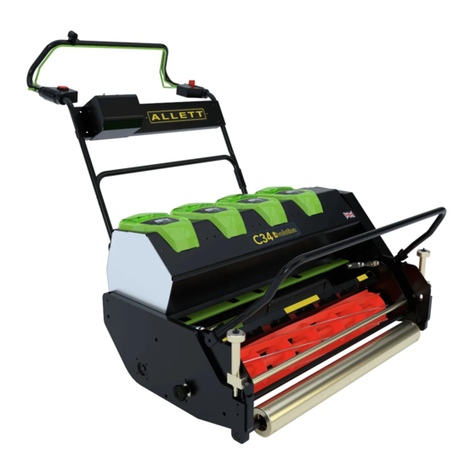
Allett
Allett C 34 User manual

Allett
Allett Kensington 17 User manual

Allett
Allett UPLIFT86 Programming manual

Allett
Allett UltraChange Series Product manual


